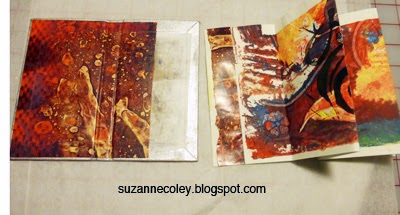Part II
There are several ways to make an accordion book.
This is how to fold a monoprint into an accordion
structure that fits inside an existing book cover.
I want this monoprint to fit into this textured
red book cover I made a few months ago.
To begin you need the following supplies:
X-acto knife
Adhesive (PVA glue & methyl cellulose)
Binding board or cover for book
Bone folder, teflon
Self-healing cutting mat
Ruler
Scissors
Small weight
Small sponge roller
Wax paper
Take your paper
and measure it.
This paper is 18 inches, 46 centimeters long.
I turn the unfinished book cover on its back and measure one side.
3 inches, 7.6 centimeters
I measure 3 inches and begin to fold the paper,
keep folding until you have 6 panels
Take the cover and line the inside boards
with kozo paper. Kozo paper is great for
binding and lining books as it is strong, archival,
translucent, and absorbent.
I use methyl cellulose mixed with PVA as an adhesive.
Methyl cellulose dissolved in water makes an archival,
pH neutral, nontoxic adhesive. My adhesive is
40% methyl cellulose and 60% PVA.
I don't use a brush to add adhesive.
I use an inexpensive painting sponge from
the hardware store.
Add adhesive to your endpaper and place over the kozo paper.
Smooth it with a teflon bone folder.
Notice that I did not cover the entire right side
with the end paper. I usually cover 1/3 of
the right side (enough to make sure that
when opened, you don't see the kozo
paper or the boards (see pic below)).
Add adhesive to the last panel of your accordion book
and attach it to the right cover. Carefully smooth
the panel to the board with your teflon bone folder.
with the end paper. I usually cover 1/3 of
the right side (enough to make sure that
when opened, you don't see the kozo
paper or the boards (see pic below)).
Add adhesive to the last panel of your accordion book
and attach it to the right cover. Carefully smooth
the panel to the board with your teflon bone folder.
Let your book dry at least 30 minutes before handling.
Accordion book closed.
Accordion book opened.















Comments